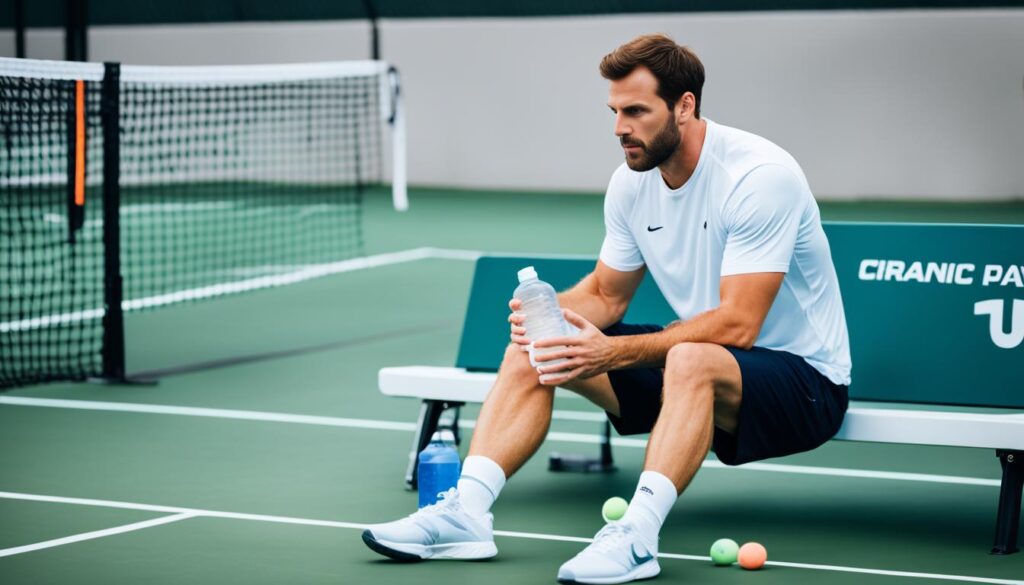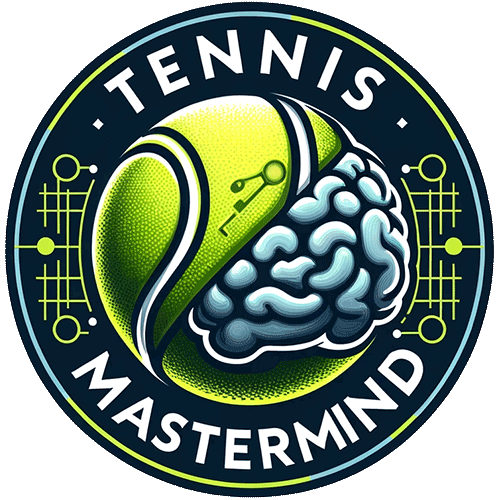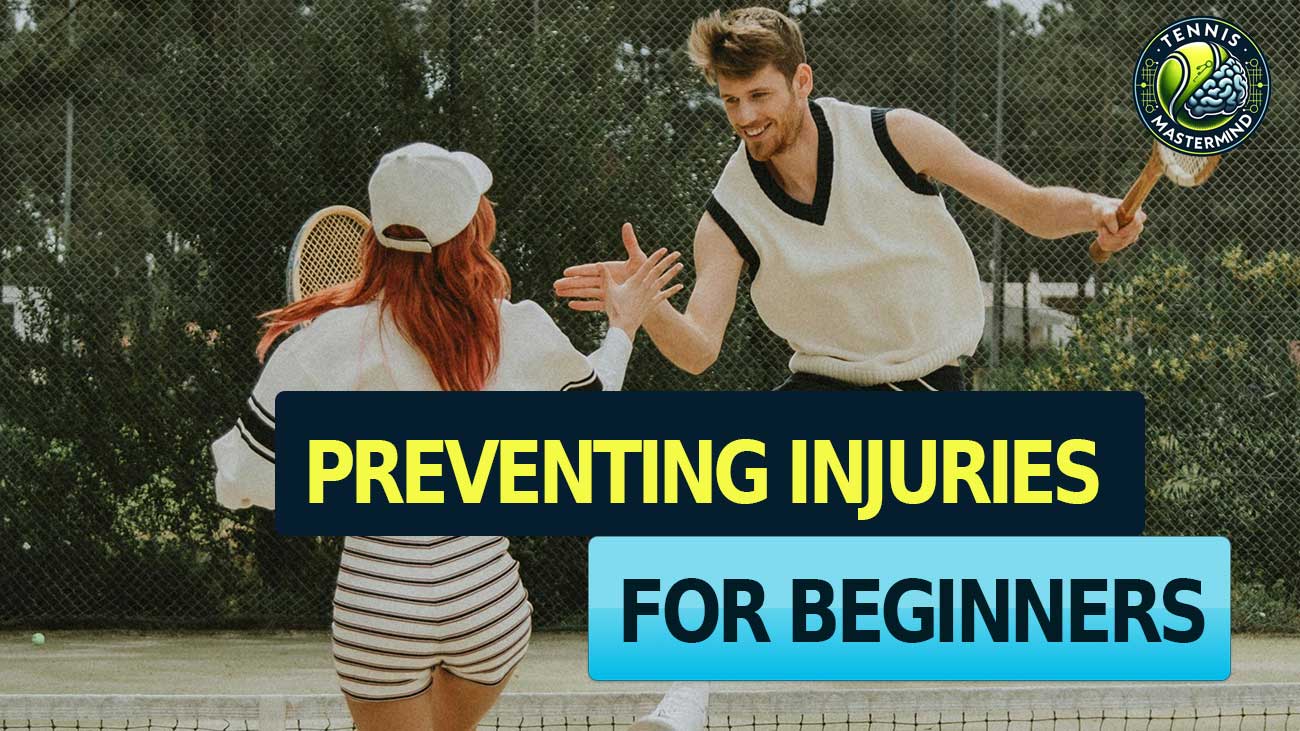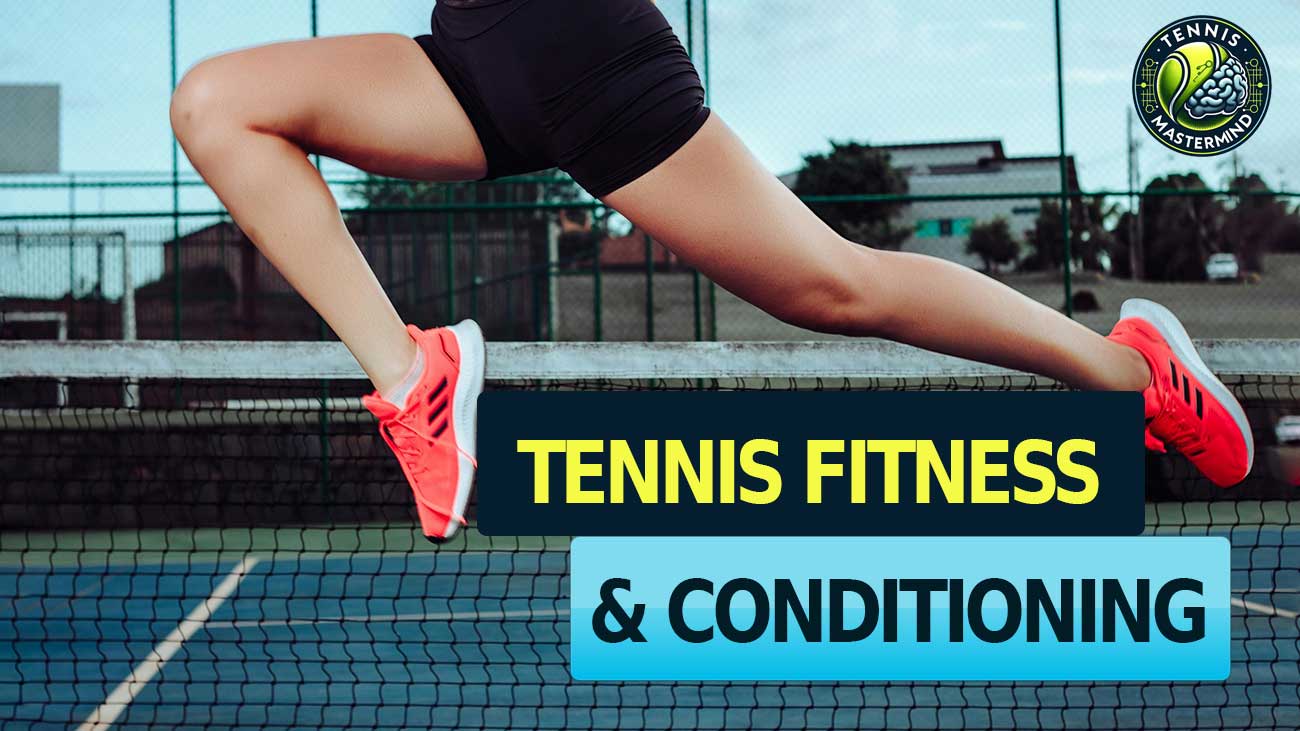Welcome to our comprehensive guide on preventing injuries for tennis beginners. Whether you’re just starting your tennis journey or looking for ways to keep yourself injury-free, we’ve got you covered. Tennis is a fun and dynamic sport, but injuries can happen if proper precautions aren’t taken. In this article, we’ll provide you with valuable tips and techniques to ensure a safe and enjoyable experience on the tennis court.
Key Takeaways:
- Preventing injuries is crucial for tennis beginners.
- Choosing the right gear, taking regular breaks, and warming up properly are important.
- Cross-training and using the right court equipment can also help prevent injuries.
- If injured, it’s important to rest and seek medical advice for proper recovery.
- By following our tips and strategies, you’ll be on your way to an injury-free tennis journey.
Choose the Right Gear for Tennis
Choosing the right tennis gear is crucial for injury prevention. As tennis beginners, we need to invest in high-quality equipment that supports our performance on the court. Let’s take a look at the essential gear we should consider:
Tennis Shoes
Our choice of tennis shoes can greatly impact our performance and safety on the court. It’s important to invest in shoes that provide adequate support, stability, and cushioning. Look for tennis shoes with features such as reinforced toe caps for durability and lateral support to prevent ankle injuries. Additionally, choose shoes with good traction to ensure proper grip on the court surface, reducing the risk of slips or falls.
Tennis Racket
The tennis racket is our most important tool on the court. It’s crucial to find a racket that suits our individual needs and playing style. Consider factors such as racket weight, head size, and grip size. A lighter racket can help prevent unnecessary strain on our arm and shoulder, while a larger head size offers a larger sweet spot for better and more forgiving shots. Don’t forget to consult with a knowledgeable professional or try out different rackets to find the one that feels most comfortable in our hands.
Tennis Attire
Wearing the right tennis attire not only enhances our comfort and performance but also reduces the risk of injury. Opt for clothing that allows for unrestricted movement, such as moisture-wicking fabrics that keep us cool and dry. Choose well-fitted clothes that don’t restrict our range of motion, as loose or baggy clothing can be a tripping hazard. Additionally, wearing proper sun protection gear, such as hats and sunglasses, can help prevent sunburn and eye damage.
By selecting the appropriate tennis gear, we can minimize the risk of injuries and maximize our enjoyment on the court.
Take Regular Breaks
Tennis players should prioritize taking regular breaks during matches and practice sessions to prevent injuries, optimize performance, and support overall well-being. By allowing the body time to rest and recover, players can reduce muscle tension, alleviate soreness, and minimize the risk of overuse injuries.
Experts recommend incorporating short breaks into the tennis routine every 20 minutes. These brief moments of rest are essential for reducing physical strain, promoting muscle relaxation, and preventing fatigue. By taking regular breaks, players can maintain their energy levels, sustain focus, and enhance their overall performance on the court.
Staying hydrated is equally vital in injury prevention and optimal performance. Hydration helps maintain flexibility, lubricate joints, and regulate body temperature. As we engage in intense physical activity, our bodies lose fluids through sweat, making it crucial to replenish them regularly.

| Benefits of Taking Regular Breaks | Tips for Staying Hydrated |
|---|---|
|
|
|
|
Remember, taking regular breaks and staying hydrated are essential elements of injury prevention and optimizing performance on the tennis court. By prioritizing these practices, players can enjoy a safer, more enjoyable tennis experience while minimizing the risk of injuries.
Warm-up and Practice Properly
When it comes to tennis, warm-up exercises are a crucial part of preventing injuries and ensuring a safe and effective practice session. By properly warming up, we can loosen stiff joints, increase blood flow, and prepare our bodies for the physical demands of the sport.
One effective warm-up exercise is a dynamic stretching routine that targets the major muscle groups used in tennis. This can include arm circles, leg swings, and trunk rotations. By incorporating dynamic stretches, we can improve flexibility and mobility, reducing the risk of strains and muscle tears during play.
Another important aspect of safe practice is focusing on proper form and technique when practicing strokes. This not only improves our overall game but also helps prevent injuries. By paying attention to our body alignment, footwork, and grip, we can minimize the stress on our muscles and joints, reducing the risk of overuse injuries or strains.
Working with a qualified tennis trainer is highly recommended, especially for beginners. They can guide us through proper warm-up routines and help us to develop correct stroke mechanics. Their expertise and guidance ensure that we warm-up and practice safely, maximizing our performance while minimizing the risk of injury.
Benefits of Warm-up and Proper Practice:
- Improved flexibility: By properly warming up, we increase our muscles’ elasticity, allowing for greater joint range of motion and reducing the risk of strains or tears.
- Enhanced coordination: Focusing on proper stroke technique improves our muscle coordination and timing, leading to more efficient movements on the court.
- Prevention of overuse injuries: By practicing strokes with proper form, we can avoid placing excessive stress on specific muscles or joints, minimizing the risk of overuse injuries.
- Increased performance: A thorough warm-up and proper practice ensure that our bodies are ready to perform at their best, leading to improved overall tennis performance.
By incorporating warm-up exercises and practicing strokes with proper technique, we can prevent injury and set the stage for a successful and enjoyable tennis experience.
| Warm-up and Practice Properly Checklist: |
|---|
| – Incorporate dynamic stretching into warm-up routines |
| – Focus on proper stroke mechanics and form |
| – Work with a qualified tennis trainer |
Cross-train for Injury Prevention
When it comes to tennis, cross-training is a game-changer. It involves incorporating a variety of exercises and activities into your practice sessions to condition your entire body and prevent the development of bad habits. By stepping outside the tennis court and engaging in alternative workouts, you can strengthen different muscle groups, improve your overall fitness, and enhance your performance on the court.
One of the key benefits of cross-training is that it prevents boredom. When you engage in the same repetitive motions over and over again, you run the risk of losing interest and motivation. By diversifying your workouts, you keep things exciting and enjoyable, ensuring that you stay committed to your training routine.
Not only does cross-training prevent bad habits, but it also helps you improve your game. By challenging your body in various ways, you develop a well-rounded skill set. For example, incorporating exercises that focus on agility and speed can enhance your footwork and reaction time on the court. Strengthening your core through activities like yoga or pilates can improve your balance and stability, allowing you to execute powerful and controlled shots.
To give you a clearer picture of how cross-training can benefit your tennis game, here’s a breakdown of different types of exercises you can incorporate:
| Type of Exercise | Benefits |
|---|---|
| Cardiovascular exercises (running, cycling, swimming) | Improves endurance and stamina |
| Strength training (weightlifting, resistance bands) | Builds muscular strength and power |
| Agility and speed drills (agility ladder, cone drills) | Enhances footwork and reaction time |
| Flexibility workouts (yoga, stretching) | Increases range of motion and prevents injuries |
| Balancing exercises (pilates, balance boards) | Improves stability and control |
By incorporating these different types of exercises into your training regimen, you’ll not only prevent the development of bad habits but also improve your game in various aspects. Remember to consult with a trainer or coach to tailor cross-training exercises to your specific needs and goals.

“Cross-training keeps your tennis practice fresh, prevents bad habits, and improves your overall game.”
Use the Right Court Equipment
Proper court equipment plays a critical role in injury prevention. When setting up a tennis court, there are several key factors to consider to ensure a safe and optimal playing environment.
Adequate Lighting for Improved Visibility
Tennis equipment: Artificial lighting
One important aspect of court equipment is artificial lighting. Good lighting is essential to improve visibility and prevent distractions during matches and practice sessions. Well-lit courts enable players to see the ball clearly, reducing the risk of misjudgment and potential mishaps.
Install high-quality lighting systems that provide uniform illumination throughout the court. Opt for energy-efficient LED lights that offer bright and clear visibility. Properly placed lighting fixtures should minimize shadows and glare, ensuring players can focus on the game without any hindrance.
Divider Screens for Privacy and Glare Reduction
Tennis equipment: Divider screens
Divider screens are another vital component of court equipment that serve multiple purposes. These screens are typically placed between adjoining courts to separate them, ensuring players have their own space and minimizing distractions.
In addition to privacy, divider screens also help reduce glare caused by sunlight or other bright light sources. By blocking out unwanted light, they improve visibility and prevent potential visual discomfort or distractions during matches.
Tennis Net Posts for Stability and Safety
Tennis equipment: Tennis net posts
When it comes to tennis net posts, stability and quality are of utmost importance. Securely anchored net posts ensure the net remains taut and in the correct position throughout the game, reducing the risk of tripping hazards or injuries.
Choose net posts made from durable materials such as steel or aluminum, ensuring they can withstand the rigors of the game. Regular inspections and maintenance will help identify any signs of wear or damage, allowing for timely repairs or replacements.
Keep Your Court Safe and Optimized
By utilizing the right court equipment, you can create a safe and optimized environment for tennis players. Adequate lighting improves visibility, divider screens provide privacy and glare reduction, while stable tennis net posts ensure player safety. Investing in quality court equipment is essential for injury prevention and enhancing the overall tennis experience.
Rest and Seek Medical Advice if Injured
If a tennis beginner sustains an injury, it is crucial to prioritize rest and seek medical advice in order to ensure a safe and effective recovery. We understand that the passion for tennis can be strong, but playing through pain can worsen the injury and prolong the recovery time. It is essential to listen to your body and give it the time it needs to heal properly.
If you experience any pain or discomfort during or after playing tennis, it is important to seek medical advice promptly. A sports medicine doctor or a healthcare professional specializing in sports injuries can provide a thorough evaluation of your condition and recommend the appropriate course of action. They can offer expert guidance tailored to your specific injury and help you develop a comprehensive recovery plan.
Remember, rest and seeking medical advice are key to a safe and effective recovery.
Recovering from an injury requires patience and adherence to a structured rehabilitation program. Your healthcare provider may recommend specific exercises, physical therapy, or other treatments to facilitate your recovery and prevent further injuries. They will guide you throughout the rehabilitation process, ensuring that you progress at a safe pace and regain strength and mobility.
While recovering from an injury, it is important to focus on proper self-care and follow your healthcare provider’s advice diligently. This may include modifications to your daily activities, exercises to improve your flexibility and strength, and practicing good nutrition and hydration habits.
Common Tennis Injuries
| Injury Type | Symptoms | Treatment |
|---|---|---|
| Tennis Elbow (Lateral Epicondylitis) | Pain and tenderness on the outer part of the elbow, weak grip strength | Rest, physical therapy, pain medication, corticosteroid injections |
| Shoulder Impingement | Pain and weakness in the shoulder, difficulty raising the arm | Rest, physical therapy, anti-inflammatory medication, corticosteroid injections |
| Ankle Sprain | Swelling, pain, and difficulty bearing weight on the ankle | RICE method (Rest, Ice, Compression, Elevation), physical therapy, ankle brace |
| Wrist Strain | Pain and swelling in the wrist, limited range of motion | Rest, physical therapy, wrist brace, pain medication |
| Knee Injuries (e.g., Patellar Tendonitis) | Pain around the knee, swelling, instability | Rest, physical therapy, knee brace, ice therapy, pain medication |
Conclusion
By following these valuable tips and strategies, tennis beginners can significantly reduce the risk of injuries and ensure a safe and enjoyable start to their tennis journey. Prioritizing injury prevention is crucial for maintaining long-term health and enabling a sustainable, injury-free tennis experience. With the right gear, regular breaks, proper warm-ups, cross-training, and attention to court equipment, beginners can establish a solid foundation for injury prevention and maximize their enjoyment on the tennis court.
Investing in the appropriate tennis gear, such as supportive shoes and a suitable racket, is essential for injury prevention. The right equipment can offer stability, protection, and comfort, reducing the likelihood of strains, sprains, and other common tennis injuries.
Taking regular breaks during matches and practices, staying properly hydrated, and allowing the body time to recover are crucial for injury prevention. Adequate rest and hydration help maintain flexibility, endurance, and mental focus, minimizing fatigue and reducing the risk of overuse injuries.
Incorporating warm-up exercises and practicing strokes with proper form and technique can help beginners improve muscle coordination, flexibility, and overall performance while minimizing the risk of acute injuries. A certified trainer can provide valuable guidance and ensure safe warm-up routines and practice sessions.
In addition to these tips, cross-training with a variety of exercises can prevent the development of bad habits, improve overall fitness, and enhance tennis skills. By engaging in complementary activities, beginners can strengthen different muscle groups, maintain interest, and reduce the risk of repetitive strain injuries.
Lastly, paying attention to the quality and stability of court equipment, such as lighting, divider screens, and net posts, is essential to minimize potential hazards and injury risks. Adequate lighting improves visibility, while divider screens and stable net posts prevent accidents and distractions on the court.
By implementing these injury prevention strategies, tennis beginners can lay the groundwork for a safe and fulfilling tennis journey, free from avoidable injuries. Prioritizing safety not only ensures a injury-free experience but also allows beginners to fully enjoy the physical and mental benefits that this fantastic sport offers.




